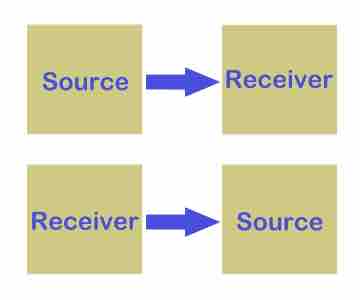New media refers to on-demand access to content any time, any where, on any digital device, as well as the interactive user feedback, creative participation, and community formation around the media content. Another important promise of new media is the "democratization" of the creation, publishing, distribution, and consumption of media content. illustrates the interactive form of communication that may exist in emerging social media.

Communication Diagram
This diagram illustrates the interactive form of communication that may exist in social media.
Most technologies described as "new media" are digital, often having characteristics of being manipulated, networkable, dense, compressible, and interactive. Some examples may be the Internet, websites, computer multimedia, video games, CD-ROMS, and DVDs. Facebook is an example of the social media model, in which most users are also participants.
There is growing consensus that new media will:
- Alter the meaning of geographic distance.
- Allow for a huge increase in the volume of communication.
- Provide the possibility of increasing the speed of communication.
- Provide opportunities for interactive communication.
- Allow forms of communication that were previously separate to overlap and interconnect.
Consequently it has been the contention of scholars such as Douglas Kellner and James Bohman that new media, and particularly the Internet, provide the potential for a democratic postmodern public sphere, in which citizens can participate in well informed, non-hierarchical debate. Contradicting these positive appraisals of the potential social impact of new media are scholars such as Ed Herman and Robert McChesney who have suggested that the transition to new media has seen a handful of powerful transnational telecommunications corporations achieve a level of global influence which was previously unimaginable.
The rise of new media has increased communication between people all over the world and the Internet. It has allowed people to express themselves through blogs, websites, pictures, and other user-generated media.
"Virtual communities" are being established online and transcend geographical boundaries, eliminating social restrictions. While this perspective suggests that the technology drives – and therefore is a determining factor – in the process of globalization, arguments involving technological determinism are generally frowned upon by mainstream media studies. Instead academics focus on the multiplicity of processes by which technology is funded, researched and produced, forming a feedback loop when the technologies are used and often transformed by their users, which then feeds into the process of guiding their future development.
Social movement media has a rich and storied history that has changed at a rapid rate since new media became widely used. The Zapatista Army of International Liberation of Chiapas, Mexico were the first major movement to make widely recognized and effective use of new media for communiques and organizing in 1994. Since then, new media has been used extensively by social movements to educate, organize, communicate, coalition build, share cultural products, and more. People are taking advantage of the Internet to produce a grassroots globalization, one that is anti-neoliberal and centered on people rather than the flow of capital. Of course, some are also skeptical of the role of new media in social movements. Many scholars point out unequal access to new media as a hindrance to broad-based movements, sometimes even oppressing some people within a movement.
New media has also recently become of interest to the global espionage community as it is easily accessible electronically in database format and can therefore be quickly retrieved and reverse engineered by national governments. Particularly of interest to the espionage community are Facebook and Twitter, two sites where individuals freely divulge personal information that can then be sifted through and archived for the automatic creation of dossiers on both people of interest and the average citizen.
New media changes continuously because it is constantly modified and redefined by the interaction between users, emerging technologies, and cultural changes.